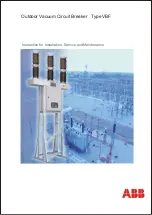
Fuse Functions
Current Limiting Fuses
Current limiting (C.L) fuses are used to increase
the
interrupting
capacity beyond that of the breaker alone or to the limit the
fault "let-thru" current downstream of their installation. The
C.L. fuses used with the RL series of circuit breakers are
special purpose
fuses having NEMA Class
"J"
or Class "L"
characteristics with a 200,000 Amps RMS Symmetrical inter
rupting capacity.
When fuse replacement is required, only use fuses per
Siemens drawing 71-142-200 with the same ratings as sup
plied with the circuit breaker. Different fuses may not properly
mount on the breaker and may have different protective
characteristics.
The current limiting fuses for the larger frame sizes, RLF-3200
and RLF-4000 mount on a separate fuse drawout assembly.
For complete description, see Fuse Carriage section on
Page 19.
Open
Fuse
Trip Device
A WARNING
Hazardous voltage.
Can cause death, severe personal injury,
electrical shock burns or property
damage.
Line voltage may be present inside trigger
fuse assembly. Do not remove trigger fuse
cover when circuit breaker is in CONNECT
osition.
The Open Fuse Trip mechanism has three functions:
1. To trip the circuit breaker mechanically when a C.L. fuse
has interrupted.
2.
To indicate which phase C.L. fuse has interrupted. The
plunger of the trigger fuse
( 13),
indicates visually
which phase C.L fuse has interrupted.
3. To retain the breaker in the trip-free position until the
trigger fuse is replaced.
Each trigger fuse is wired in parallel with one of the C.L fuses.
When the C.L fuse interrupts, its associated trigger fuse also
opens and releases a plunger which releases a
precompressed spring contained in the trigger fuse housing.
On the small breakers, this plunger operates arm (3) which
moves the latch (12), releasing the spring-loaded lever (4).
This rotates circuit breaker trip flap link (7). This trips the
circuit breaker and holds the circuit breaker in the mechanical
trip-free position.
On the circuit breakers supplied with a separate fuse car
riage, the trigger fuses are mounted on the fuse carriage, and
are used for visual identification of the faulted phase. Tripping
of the breaker is accomplished through a power supply
connected across the main fuses of the fuse carriage. The
voltage from this supply is applied through the secondary
control wiring to the coil of a solenoid mounted open fuse trip
device on the circuit breaker. The plunger of the solenoid
operates arm (3). The balance of the operation is the same
as for the trigger fuse operated device.
The circuit breaker will remain trip free (cannot be closed)
until the trigger fuse has been replaced and the associated
trip mechanism reset lever ( 4) has been manually reset
(pushed up).
To remove the trigger fuse, remove screws (15) remove
plastic cover (5) then the trigger fuse.
To insert the trigger fuse, reverse the above procedure.
NOTE: ·The trigger fuse {13) must
be
inserted with the
plunger facing arm {6). T he gap dimension of 0-.03•
(0.8mm) maximum must
be
maintained for each fuse.
Be
sure to replace both the trigger fuse and its correspond
ing C.L fuse before the breaker is reset.
17
www
. ElectricalPartManuals
. com










































